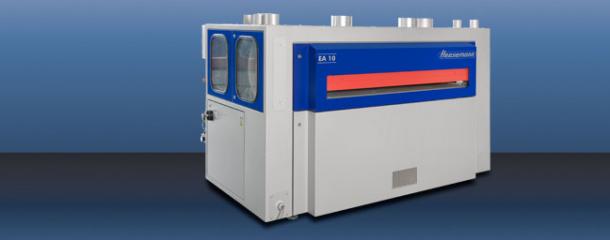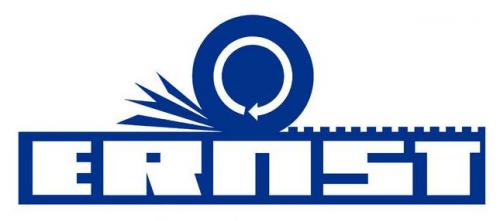Chips and dust are produced in large quantities during woodworking. Extraction systems remove a large part of it at the moment of the machining process. However, fine dust remains on the surface of the workpiece and chips collect in drill holes and grooves. Thorough cleaning is therefore particularly necessary before surface coating, final assembly or packaging.
Cleaning tools and cleaning media
Brushes, rotating longitudinally to the feed direction
| Cleaning potential | pick up of large quantities of dust and convey towards the extraction system; can only remove machining residues from longitudinal grooves to a limited extent and not from drill holes; they do not remove dust over the entire area |
| Application | Outlet of wide belt sanders, inlet of lacqering systems |
| Example machine | BARBERAN LP |
Sword brushes, wiping across the feed direction
Blow-off nozzles, rotating
| Cleaning potential | swirls up dust and puts it in a state of suspension so that it is captured by the suction stream; suitable for dedusting profiled surfaces; unsuitable for cleaning drill holes, pockets and grooves; overcomes static forces of attraction between workpiece and particles only to a limited extent |
| Application | Outlet of wide belt sanders, inlet of lacquering systems and glue spreaders in front of membrane presses |
| Example unit | COSTA LEVIGATRICI SR |
| Special form | WANDRES tornado nozzles |
Blow-off ducts
| Mode of operation | Most manufacturers focus on creating as high a circulating volume flow as possible in the machine. In the circulation process, the dust-laden air passes through a fine dust filter, which must be emptied from time to time. In such cases, the machine is equipped with fans. The air flow is directed obliquely onto the workpiece surface through blow-off channels with slot-shaped air outlets. To create a certain negative pressure, such machines must be connected to the central exhaust system. |
| Example machine | JHM TWISTER |
Blow-off nozzles, fixed
| Cleaning potential | puts dust in a state of suspension so that it is captured by the suction stream; conditionally suitable for cleaning bore holes, pockets and grooves; unsuitable for removing dust from profiled surfaces; overcomes static forces of attraction between workpiece and particles only to a limited extent. |
| Example unit | WANDRES power nozzles |
Ionisation
The static attraction forces of the workpieces cause the cleaned surfaces to attract dust particles anew. These forces can be neutralised with the help of ionising devices.
The right combination
Often cleaning units are combined so that a dust removal brush pre-cleans, an ionising unit neutralises the static attraction forces and finally rotating blow-off nozzles remove the dust. The cleaning system of WANDRES works somewhat differently. Here, the air pre-cleaning is carried out first, followed by the wiping cleaning by means of sword brushes.
















